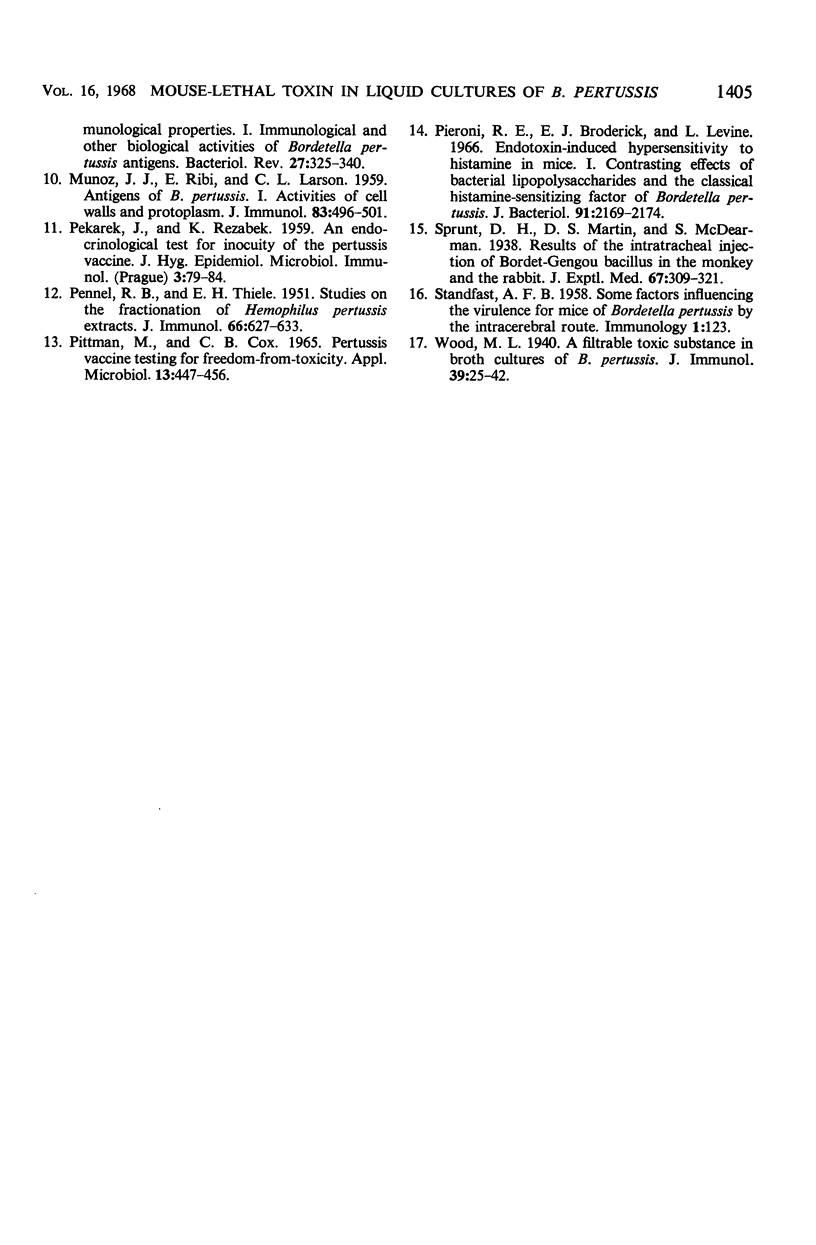Abstract
The mouse-lethal toxin present in liquid cultures of most smooth strains of Bordetella pertussis is known to originate in the cytoplasm of the organism but to be most lethal for mice when released into the supernatant fluid. It is also recognized that cell degeneration and lysis occur in liquid cultures during the stationary and decline phases of growth. For these reasons, it is generally believed that most of the toxicity demonstrable in liquid cultures at the time of harvest is released during the later stages of cultivation, when high alkalinity and aging of cells favor lysis. However, the results reported here have indicated that high levels of mouse-lethal toxicity arise during very early log phase and that the peak of toxicity is reached before the end of the log phase. No further increase in toxicity was observed during stationary and decline phases. The very early appearance of toxicity could not be explained by the presence in the inoculum of a proportion of dead and degenerating cells, and it is concluded that the toxin is produced mainly by actively growing cells. This was confirmed by tests on organisms growing in continuous culture. Electron-microscopic examination of cells from a very early log-phase culture revealed the presence of large numbers of small vesicles on the cell walls of about 5% of the population. It is suggested that these vesicles may be associated with the releases of toxin from living cells. It is concluded that no useful reduction in the toxicity of cultures would result from harvesting before the end of the log phase of growth.
Full text
PDF





Images in this article
Selected References
These references are in PubMed. This may not be the complete list of references from this article.
- BANERJEA A., MUNOZ J. Antigens of Bordetella pertussis. II. Purification of heat-labile toxin. J Bacteriol. 1962 Aug;84:269–274. doi: 10.1128/jb.84.2.269-274.1962. [DOI] [PMC free article] [PubMed] [Google Scholar]
- Beaton C. D. An electron microscope study of the mesosomes of a penicillinase-producing staphylococcus. J Gen Microbiol. 1968 Jan;50(1):37–42. doi: 10.1099/00221287-50-1-37. [DOI] [PubMed] [Google Scholar]
- Cohen S. M., Wheeler M. W. Pertussis Vaccine Prepared with Phase-I Cultures Grown in Fluid Medium. Am J Public Health Nations Health. 1946 Apr;36(4):371–376. [PMC free article] [PubMed] [Google Scholar]
- FRAPPIER A., GUERAULT A. Etude des cultures liquides de H. pertussis. I. Répartition des propriétés toxiques et dermonécrotiques dans les phases liquides et bactériennes. Rev Can Biol. 1954 Dec;13(5):416–430. [PubMed] [Google Scholar]
- MUNOZ J., RIBI E., LARSON C. L. Antigens of Bordetella pertussis. I. Activities of cell walls and protoplasm. J Immunol. 1959 Nov;83:496–501. [PubMed] [Google Scholar]
- PEKAREK J., REZABEK K. An endocrinological test for innocuity of the pertussis vaccine. J Hyg Epidemiol Microbiol Immunol. 1959;3(1):79–84. [PubMed] [Google Scholar]
- PENNELL R. B., THIELE E. H. Studies on the fractionation of Hemophilus pertussis extracts. J Immunol. 1951 Jun;66(6):627–633. [PubMed] [Google Scholar]
- PITTMAN M., COX C. B. PERTUSSIS VACCINE TESTING FOR FREEDOM-FROM-TOXICITY. Appl Microbiol. 1965 May;13:447–456. doi: 10.1128/am.13.3.447-456.1965. [DOI] [PMC free article] [PubMed] [Google Scholar]
- Pieroni R. E., Broderick E. J., Levine L. Endotoxin-induced hypersensitivity to histamine in mice. I. Contrasting effects of bacterial lipopolysaccharides and the classical histamine-sensitizing factor of Bordetella pertussis. J Bacteriol. 1966 Jun;91(6):2169–2174. doi: 10.1128/jb.91.6.2169-2174.1966. [DOI] [PMC free article] [PubMed] [Google Scholar]
- STANDFAST A. F. Some factors influencing the virulence for mice of Bordetella pertussis by the intracerebral route. Immunology. 1958 Apr;1(2):123–134. [PMC free article] [PubMed] [Google Scholar]



